
Earthworm Jim is a 1994 run and gun platform game developed by Shiny Entertainment, featuring an earthworm named Jim, who wears a robotic suit and battles the forces of evil. The game was released for the Sega Genesis and Super Nintendo Entertainment System, before being subsequently ported to a number of other video game consoles.

Earthworm Jim 2 is a 1995 run and gun platform video game and the sequel to Earthworm Jim, and the second and final game in the Earthworm Jim series developed by original creators Doug TenNapel, David Perry, and Shiny Entertainment. It was released in late 1995 and early 1996 depending on region and video game console, initially being released for the Sega Genesis and Super Nintendo Entertainment System, before being ported to other platforms.
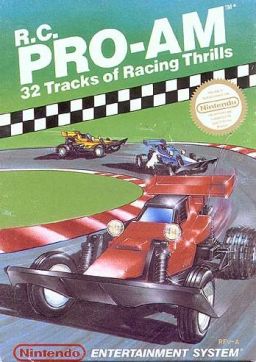
R.C. Pro-Am is a racing video game developed by Rare and published by Nintendo for the Nintendo Entertainment System. It was released in North America in February 1988, and then in Europe on April 15. Presented in an overhead isometric perspective, a single player races a radio-controlled car around a series of tracks in vehicular combat. Each track qualifies its top three racers for the next track. Collectible power-up items improve performance, hazards include rain puddles and oil slicks, and missiles and bombs can temporarily disable opponents. Originally titled Pro Am Racing, it was ported to the Sega Genesis in 1992 as Championship Pro-Am, an enhanced remake with enhanced graphics and additional features. R.C. Pro-Am spawned two sequels: Super R.C. Pro-Am in 1991, and R.C. Pro-Am II in 1992.
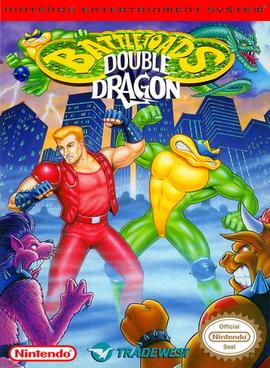
Battletoads/Double Dragon is a 1993 beat 'em up developed by Rare and published by Tradewest. It was originally released for the Nintendo Entertainment System and later ported to the Mega Drive/Genesis, Super NES, and Game Boy. Retro-bit Publishing has re-released the 8-bit NES version in early 2022 with plans to release the 16-bit versions later this year.

Snake Rattle 'n' Roll is a platform video game developed by Rare. It was published by Nintendo and released for the Nintendo Entertainment System in North America in July 1990 and in Europe on March 27, 1991. The game features two snakes, Rattle and Roll, as they make their way through eleven 3D isometric levels. A Mega Drive version was released by Sega in June 1993 with an extra level. Snake Rattle 'n' Roll was developed by Rare members Tim Stamper and Mark Betteridge. The music was composed by David Wise and was inspired by "Shake, Rattle and Roll" and other 1950s-era songs.

Shaq Fu is a 2D fighting game published by Electronic Arts for the Sega Genesis and Super NES on October 28, 1994. It was developed by Delphine Software International. Versions for the Game Gear, Game Boy, and Amiga followed in 1995. Former professional basketball player Shaquille O'Neal is the player character.
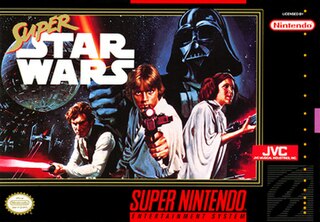
Super Star Wars is a 1992 action video game developed by LucasArts and Sculptured Software for the Super Nintendo Entertainment System. It is based on the 1977 film Star Wars. It was released by JVC Musical Industries in Japan and Nintendo in North America in 1992 and Europe in 1993. The game was followed by two sequels based on the subsequent Star Wars films, Super Star Wars: The Empire Strikes Back (1993) and Super Star Wars: Return of the Jedi (1994). The game was re-released in November 1996 as part of Nintendo's Player's Choice series. It was released on the Wii’s Virtual Console by LucasArts in 2009.

Batman: Return of the Joker is a 1991 platform video game, the follow-up to Sunsoft's first Batman game on the Nintendo Entertainment System. Unlike that game, which was based on the 1989 Batman film directed by Tim Burton, Return of the Joker is entirely self-contained and based more on the modern comic book iteration of Batman, but the Batmobile and the Batwing are featured from the 1989 film. A remake of Return of the Joker, titled Batman: Revenge of the Joker, was released on the Sega Genesis by Ringler Studios in 1992. A Super NES version of Revenge of the Joker was completed but never officially released; a ROM image surfaced online in later years.
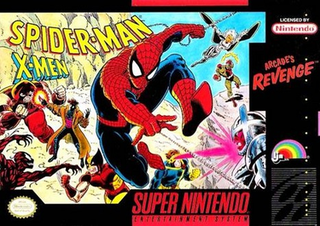
Spider-Man and the X-Men in Arcade's Revenge is a video game released for the Super NES in 1992 by LJN. It was released for the Genesis and Game Gear as well as the Game Boy. The game features Marvel Comics characters Spider-Man and the X-Men as they battle their captor, the villainous Arcade to escape Murderworld.
Hect (ヘクト) or Hector was a Japanese video game developer and publisher. It had a Virtual Boy game in development, entitled Virtual Battle Ball; however, it was eventually canceled.
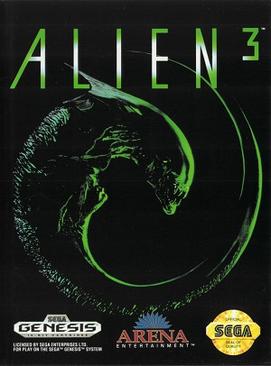
Alien 3 is a run and gun game based on the 1992 film of the same name. It was released for the Genesis and Amiga in 1992, then for the Commodore 64, Game Boy, Game Gear, Nintendo Entertainment System, Super Nintendo Entertainment System, and Master System.

Viewpoint is an isometric-scrolling shooter arcade game developed by Aicom and originally released in 1992 by Sammy and SNK for the Neo Geo hardware family. It was met with a highly positive critical response upon release for its cutting-edge visuals and hip hop-influenced soundtrack, though later ports for the Sega Genesis and Sony PlayStation saw much more mixed reviews.
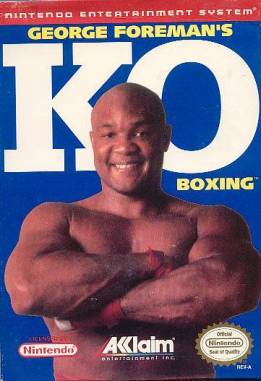
George Foreman's KO Boxing is a sports video game produced by Acclaim, featuring boxer George Foreman, released in 1992. Three years later, Acclaim released another game with Foreman: Foreman For Real.

The Adventures of Batman & Robin is a series of video game adaptations released between 1994 and 1995 featuring the DC Comics characters Batman and Robin based on Batman: The Animated Series. The games were released for numerous platforms, with the Genesis, Game Gear, and Sega CD versions published by Sega while the Super NES version was published by Konami.
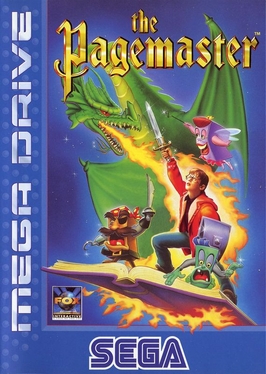
The Pagemaster is a platform game released in conjunction with the 1994 film The Pagemaster for the Super Nintendo Entertainment System, Game Boy, and Sega Genesis. It was developed by Probe Software, published by Fox Interactive and distributed by FoxVideo.
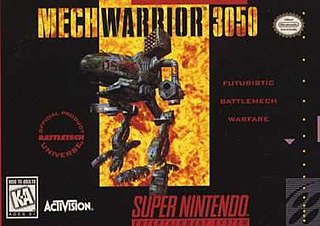
MechWarrior 3050, also known as BattleTech in its original Sega Genesis release and in Japan as BattleTech 3050 (バトルテック3050), is a 1994 mech-based video game developed by Malibu. The first BattleTech based game to be released for the Sega Genesis, it was later ported to the Super Nintendo by Activision as MechWarrior 3050. The Super Nintendo game was localized and published in Japan by Ask Group.
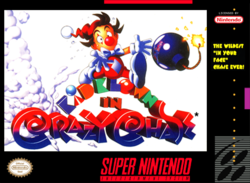
Kid Klown in Crazy Chase is a platform video game developed and published by Kemco for the Super Nintendo Entertainment System. It was released in North America in September 1994, Japan on October 21, 1994 and in Europe in 1995. The game features the Kid Klown, the player character who is tasked with rescuing the Princess Honey from the villain Black Jack. Players view gameplay from an isometric perspective as Kid Klown pursues a lit fuse in order to stop it from reaching a spade bomb. The game was re-released for the Game Boy Advance as Crazy Chase and features 11 new levels, four mini-games, and a multi-player mode. The re-release was released in Europe and North America in October 2002, while a release in Japan was planned but ultimately canceled. It was met with mixed reception from critics, who found it to be inferior to other games of its type. The game has a Japan-exclusive sequel Kid Klown in Crazy Chase 2: Love Love Hani Soudatsusen released for the Sony PlayStation in 1996.
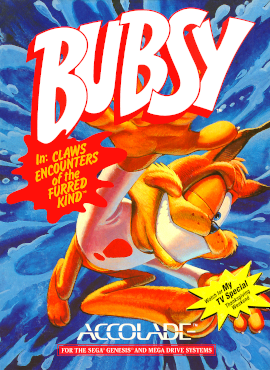
Bubsy in: Claws Encounters of the Furred Kind, often shortened to Bubsy, is a platform game first released for the Sega Genesis and Super Nintendo Entertainment System by Accolade in 1993. It is the first entry in the Bubsy series of video games. The game's title is a play on words in reference to the film Close Encounters of the Third Kind, with the game revolving around Bubsy defending the planet's supply of yarn balls from alien invaders.

Bubsy 2 is a platform video game, the sequel to Bubsy in Claws Encounters of the Furred Kind, and the second game in the Bubsy series. It was originally released by Accolade in 1994 for the Sega Genesis, Super NES, and Game Boy, and re-released for Windows through Steam on December 17, 2015.

Monopoly is a video game based on the board game Monopoly, released on Game Boy, Genesis, NES, and SNES. Developed by Sculptured Software and published by Parker Brothers, this title was one of many inspired by the property.

















